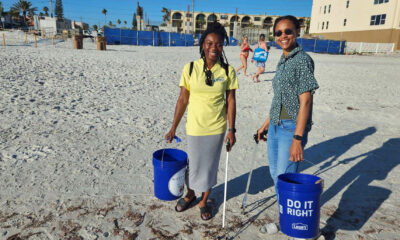Know
Inside the muddied closure of Piney Point

Tampa attorney Herb Donica wants people to know his sole mission is to ensure the former Piney Point phosphate plant closes as safely and quickly as possible, despite the daily difficulties.
A Manatee County Circuit Court appointed Donica – who has extensive environmental law experience and represented a previous owner through bankruptcy proceedings in 2001 – as the facility’s receiver in August 2021. His appointment followed the discharge of 215 million gallons of nutrient-rich contaminated water into the bay to avoid flooding surrounding neighborhoods in April of that year.
Donica, who practiced law for over 30 years, stressed that unlike other companies that managed the site, he is not beholden to profit margins or shareholders.
As the receiver, Donica now has jurisdiction over the tumultuous property and is tasked with hiring contractors for its cleanup and remediation. The state legislature appropriated a $100 million fund in May 2021 for Piney Point’s permanent closure, which the Florida Department of Environmental Protection (FDEP) oversees and administers. However, Donica relayed that supply chain issues and mother nature complicate an already tenuous and time-consuming process.
“It’s like a cocker spaniel pushing a volleyball uphill with a stick,” said Donica with a laugh. “Eventually, he’ll do it, but it just looks awful.”

Longtime Tampa attorney Herb Donica is the facility’s court-appointed receiver.
Donica said engineers working for the Ardaman & Associates consultancy group expect a total closure of Piney Point by December 2024 – although he fears it could take longer and the potential for another leak remains.
First and foremost, a contractor must close the phosphogypsum stacks at the site (phosphogypsum contains radioactive material and toxic heavy metals). New Gyp Stack South, a 67-acre pond that once held nearly 400 million gallons of seawater mixed with contaminated processed water, was the source of the leak that forced the governor to declare a state of emergency, and local officials to evacuate nearby residents.
Donica said that stack – one of four – was previously dry and ready for closure. Mother nature had other ideas, and workers at the shuttered plant released 4.5 million gallons of rainwater from the pond into the bay last week. At the time, the FDEP stated the water was not rife with nitrogen and kept away from potentially hazardous areas.
Contractors, explained Donica, are recontouring the inside of the problematic gyp stack so it will no longer hold stormwater. Once complete, he said it would drain into a system under the pond’s liner as part of an FDEP-approved plan.
After the water is gone, Donica said workers would install a new liner and cover it with two feet of topsoil and grass. He believes that will mitigate any potential for leaks, as the liners were not designed to lay bare and absorb heat, adding that the sun’s UV rays make the plastic casings brittle and weak over time.
“We’ve had other leaks over the last few months that we’ve had to repair,” said Donica. “We’ve had dive crews in there to do underwater repairs of a leak or tears in the liner, and we’ve actually budgeted for more of that.”
He noted that divers have also encountered alligators, with the largest measuring 11 feet, five inches. Trappers have removed eight from the facility since Donica began his receivership.
About 100,000 gallons of stormwater is transferred to Manatee County’s treatment plant daily, said Donica. He added that a system that accelerates evaporation by spraying water into the air is also removing around 100,000 gallons per day, as is another mechanism that employs a “drip method.”

A system that accelerates evaporation sprays rapidly accumulating stormwater into the air.
He said the goal is to decrease pressure and keep ponds below capacity, but heavy rains can negate those efforts.
“Every inch of rain that falls on the stack system is another four million gallons,” said Donica. “And if we don’t get rid of the water, we’re not going to be able to commit to a construction plan that will allow rain to fall and then drain naturally into our stormwater management program.”
About 400 million gallons of processed water remains onsite, although Donica said most of that is seawater. According to researchers, that water contributed to the worst red tide event the region has witnessed in 50 years. Since then, explained Donica, a “high-tech company” called Phosphorous Free Water Solutions has treated the mixture in a continuous loop.
While he said the result is 98-99% nutrient-free water, the alkalinity is still too high to release into the bay. So, deep injection wells will pump the remaining 400 million gallons onsite 3,300 feet below ground level.
There are only three ways to get rid of the water, he added. He said they spray it up to evaporate, but this would never cancel rainfall amounts. Workers can release it outwards, into the bay, and “nobody wants to do that because they’re convinced it’s the worst thing possible – and again, it’s clearly possible that it did accelerate red tide.”
He said the only remaining option is bringing it down – through deep injection wells.
Donica relayed that organizations have used those wells for 70-80 years, which extends far below the drinking water level of around 300 feet underground.
“Earth that deep is a natural filter that will actually clean that water up over the next many, many decades before it will naturally flow out to the Gulf underneath everything else,” he said. “It’s probably the safest way to do it.
“I didn’t like it when I heard about it, but when we examined what we could do to accelerate the evaporation – all we can do is give ourselves a little bit of room to endure the next rainy season.”
After a series of delays, said Donica, Manatee County officials are drilling the well across the street from Piney Point. He finished a treatment plan with the county on Tuesday, and “his understanding” is that the well is nearing completion. Once it is ready, he said it would pump a million gallons of the processed water underground daily.
“They are estimating – I think, the last I heard – was maybe July or August 2023,” relayed Donica. “They hope to move that up.”
However, he said there are other steps to take before that happens, along with supply chain concerns.
“I’m supposed to close it out by the end of 2024, and the way it looks right now, we’re probably going to go past that.”
For more information on the Piney Point receivership, visit the website here.







